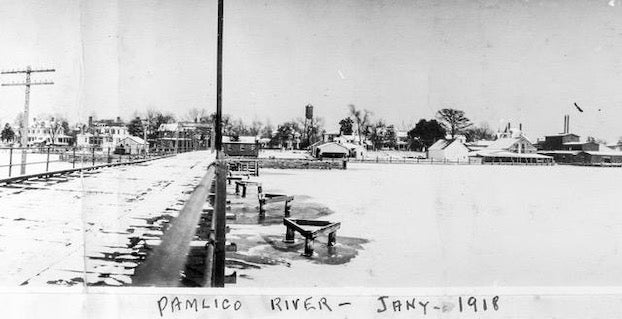When the “Big Chill” hit Eastern NC
Published 10:38 am Friday, December 30, 2022

- Photo curtesy of Brown Library in Washington
|
Getting your Trinity Audio player ready...
|
Do you think the “polar vortexes” of late have made it unusually cold in eastern North Carolina? Granted, we know it’s been cold enough the past week for Jack’s Creek (historically known as Windmill Creek) to ice over. But it hasn’t been anywhere near as cold as it was during ten days of sub-freezing temperatures during the winter of 1917-1918.
As the New Year approached in late December of 1917, the river and sound region of North Carolina was figuratively “in the icebox.” Albemarle and Pamlico sounds were completely frozen over. Lighthouse keepers in both sounds became stranded in their screw-pile lighthouses for weeks without fresh supplies or food. Commercial fishermen and their boats found themselves icebound without the luxury of modern winter weather warnings.
For the first 48 hours of the cold spell, the temperature never rose above 20 degrees in Washington. The low registered at 2 above zero. December 31, 1917, Washington Daily News headline read “Skating Today on the Pamlico River.” The story stated that the river between the downtown waterfront and Castle Island had frozen to a thickness of two inches. Several brave souls tested their ice skating skills on the thin ice and lived to tell about it. In anticipation of the ice getting even thicker, the story added, “Skates are greatly in demand and everybody is trying to borrow someone else’s.” Who knew more than one pair of ice skates would have existed in Washington?
But fun and merriment soon changed to suffering and misery. By January 3, the mercury had hit one degree below zero. The water pipes and wells in almost all the town’s homes became frozen entirely, along with the radiators of many cars. The ice reached a thickness of eight inches on the Tar and Pamlico rivers and Pamlico Sound. It was said that walking the entire distance from the mouth of the Pamlico River to Tarboro on the frozen waterway was possible. Of course, the frozen conditions made it impossible to travel by boat. Freight boats that ran from Washington and delivered to the Outer Banks villages could not make their runs for more than three weeks, and food and supplies ran dangerously low.
In addition, the region was hit by several heavy snowstorms. Train and motor vehicle travel ground to a halt. Soon fuel, food, and water supplies ran low in town. The Washington Daily News stated, “‘ Light bread’ has been out for the past few days. None of the stores have had any for sale, although they expect to get in some within a day or two. Kerosene is almost out now. There is [sic] less than fifty gallons in the entire town.” Knowing how essential seafood was to the diets of the Washington populace, one headline announced in bold letters, “No Oysters Are to Be Had in the City.” Because of the lack of fuel, town officials and the Associated Charities, a local aid society, did their best to provide heat and shelter for the needy. The town jail and the A.M.E. Zion church served as shelters and kept big fires going for those without fuel.
Finally, on January 7, the paper announced, “Thermometer Takes Big Jump.” The mercury reached 45 degrees, and an ensuing hard rain swept away much of the snow. Over the next several days, the warmer temperatures allowed the ice-covered river to thaw along with frozen water pipes. Slowly the improving weather conditions allowed commerce to resume, thus permitting food and fuel supplies to return to normal.
So, the next time the Weather Channel heralds the arrival of the next polar vortex, keep in mind the time the “Big Chill” iced over the sounds and rivers of eastern North Carolina.
Ray Midgett is a Washington resident and the past president of the Historic Port of Washington.





